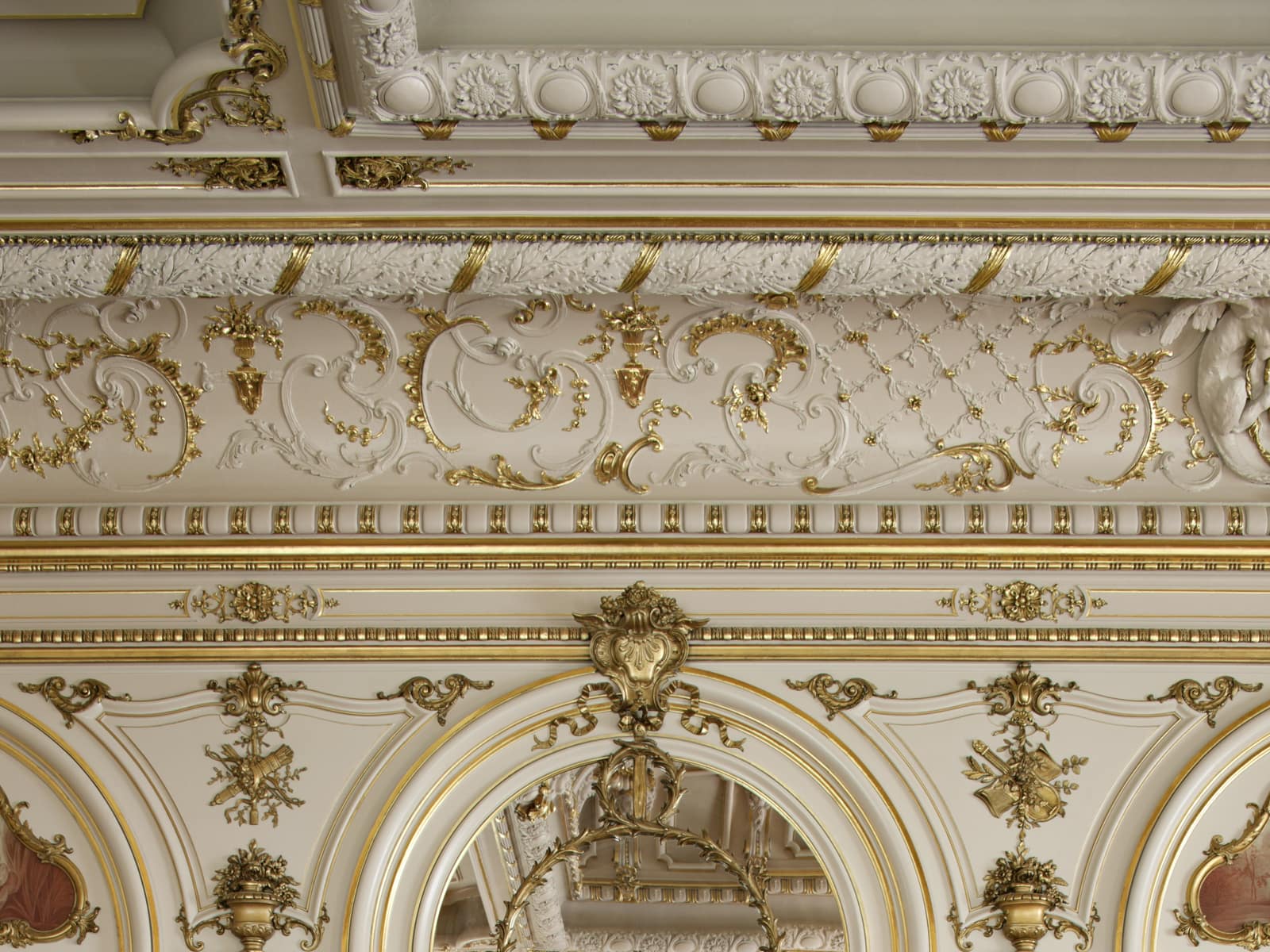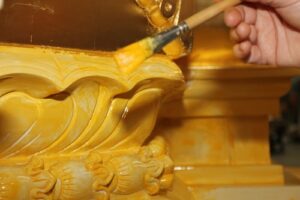There are two main gilding techniques: Architectural oil-based gilding and water gilding. The two treatments offer differing results, namely reflectivity. Water gilding relies on the use of an agate stone to burnish the metal to a smooth mirror like finish. The different adhesives and techniques are utilized based on the requirements of the project including the magnitude, location, and desired results. Of the two techniques, water gilding is the more complicated method and can only be utilized for select types of projects. Water gilding is typically set aside for furniture, frames and the most delicate architectural elements in very ornate settings. Architectural gilding with oil (or modern acrylic) adhesive size is a slightly less arduous approach, as “burnishing” is limited to removal of the gold skewing. Skewing are excess fragments of gold hanging from the surface that get removed with a soft brush or cloth.
Prior to selecting a technique, the location, materials, and effect must first be considered. All exterior projects as well as gilding stone or metal will require the oil-based approach. Once the desired effect and approach are selected, both techniques require thorough surface preparation. Assuring the substrate is carefully cleaned and prepared is critical to guaranteeing the longevity of the gilded application. Additionally, the environment must also be dust free at the time of gilding in order to minimize any dirt particles adhering to the size.
Oil-Based Gilding
Gilding with an oil size is the most durable and water-resistant alternative. For this reason, oil-based gilding is used for exterior gilding of domes and architectural elements as well as many interior projects. Known for durability and withstanding weather and time, oil-based gilding is by far the most common and cost-effective approach to gilding. In this approach, an oil size is applied to the prepared surface. The size is left to “set up” until the size becomes tacky to the touch, but not wet. It is important to never apply metal leaf to a wet surface, the material will lose its luster, a condition known as “flooding the gold”. The results of this will be an inconsistent appearance and less durability. Once the surface is tacky, the gold leaf is applied to the surface and the skewing’s “burnished” (brushed) away.

Fiberglass panel getting cleaned and primed in preparation for the oil-based gilding process.
(Left) Application of size in oil-based gilding process. (Right) Application of gold leaf in oil-based gilding process.
(Left) Skewings close-up, ready for burnishing in the oil-based gilding process. (Right) Gold leaf after burnishing in the oil-based gilding process.
Water-Gilding
Water-gilding is typically utilized for detailed work, frames, statues, and antique furniture. The process of water-gilding is typically more labor intensive but offers a slightly different effect than oil-based gilding, namely the possibility for a highly polished finish. Following the required substrate preparation previously mentioned, one or more coats of gesso are applied to insulate the surface and provide and ultra-smooth layer that is easily sanded with high grit papers (600-1000). A bole is applied, which is a mixture of colored clay and rabbit skin glue, in layers to the surface and left to dry. Once the bole is completely dry, a water size is brushed onto the surface to activate the glue in the bole. This glue is made of animal protein, such as Hyde glue. However, historically, the adhesive was often Isinglass, which is a by product of sturgeon fish. The gold is then cut to the size of the area and adhered to the surface with a soft hairbrush applicator. The installer must work quickly and in small sections because the water glue is absorbed in the bole and can also evaporate. A few square inches at a time get worked on. Once the gold application is complete, the surface may be left matte or burnished to achieve a mirror like brilliance.
(Left) Stop flutes during cleaning process in preparation for water gilding. (Right) Capitol base after cleaning and stripping in preparation for water gilding.
(Left) Application of gesso to stop flutes in water gilding process. (Right) Stop flutes and capital base after application of bole in water gilding process.
(Left) Tamping of gold leaf with cotton after application on stop flutes in water gilding process. (Right) Application of gold leaf on capital base in water gilding process.

Burnishing of capitol base after application of gold leaf with an agate stone burnisher in the water gilding process.

Completed water gilding for the stop flutes and capitol base after the restoration.
Gilding and the use of metal leaf is an ancient and noble art form used to highlight or elevate an architectural or ornamental element. With both approaches, cleanliness and order are critical to achieving a successful product. Thorough understanding of the conditions and materials at hand is necessary to properly select the gilding approach and develop an effective gilding program. The art of gilding requires patience and attention to detail as well as competence in old world techniques. When done correctly, the results are truly magnificent.

The Warner Ballroom at the Cosmos Club contains both oil based gilding and water gilding.



























